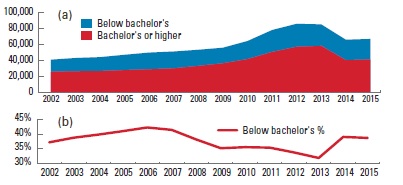
The number and mix of programs completed at Iowa’s post-secondary institutions reveal evolving preferences among people preparing to enter the workforce or seeking to upgrade their skills.
Figure 1 illustrates recent trends in the number of degrees and certificates awarded by Iowa’s technical and vocational institutions, colleges, and universities. In the 2014–2015 academic year, students completed 66,500 post-secondary educational programs in Iowa. Total completions were up slightly from the prior year but still below peak levels achieved after the 2007–2009 recession. Associate and other degrees and certificates below the bachelor’s level accounted for 39 percent of 2014–2015 awards, up from a low of 32 percent in 2013.
Figure 2 illustrates the distribution of recent program completions by field of study and program duration. Health- and business-related fields lead all program areas in terms of overall completions. Students pursuing health-related fields are evenly split among bachelor’s and higher degree programs and programs below the bachelor’s level. In business-related programs, about one-quarter of awards are made below the bachelor’s level.

Completions in precision production programs numbered fewer than one thousand per year from 2013 to 2015. Considering only awards below the bachelor’s level, precision production ranked just below mechanic and repair technologies and just above computer and information sciences and support services.
People generally invest in education with expectations for improving their future employment and earnings opportunities. Examining how students are investing their educational dollars and their time to identify areas of perceived career opportunity might help Iowa’s employers compete more effectively for the future workforce members.
A version of this article was published in the Fall 2016 edition of CIRAS News. To read more of that edition or others, please explore elsewhere on our website.